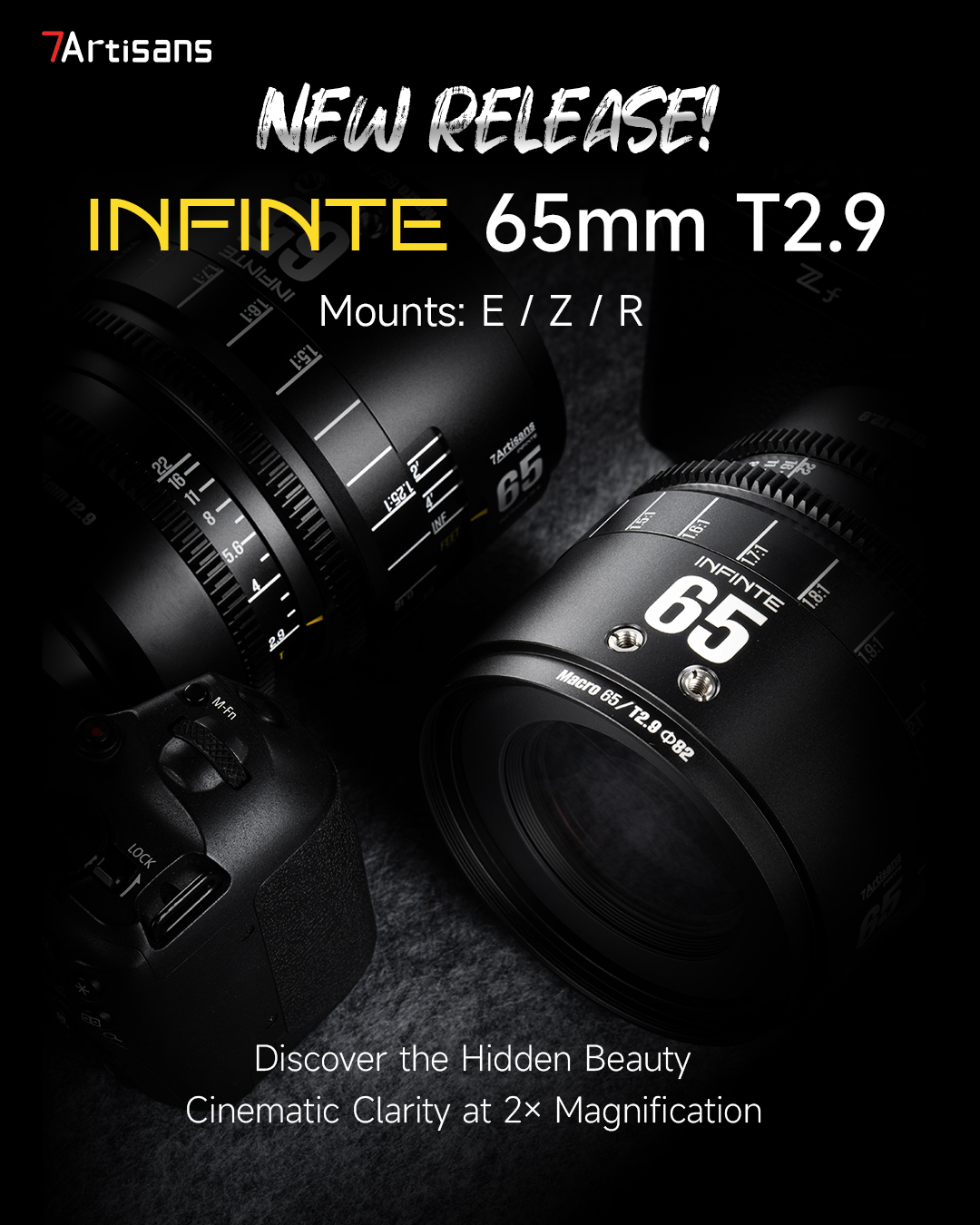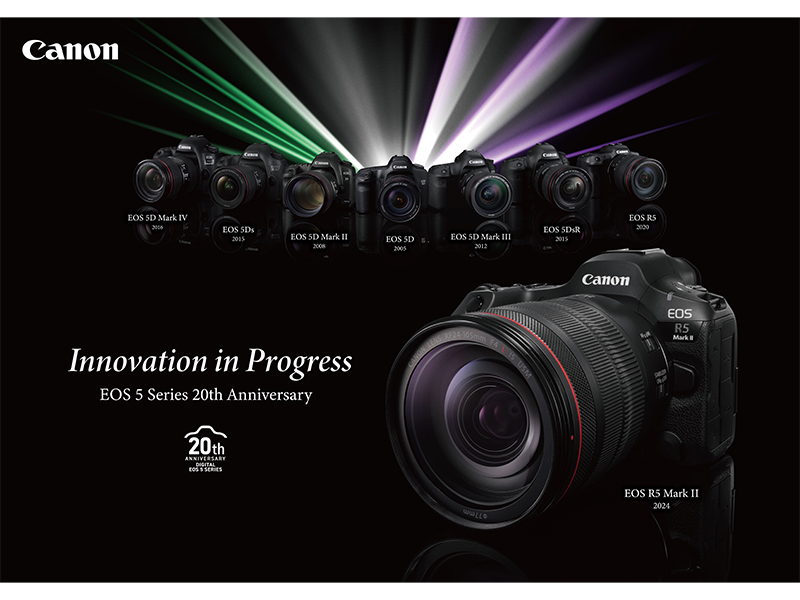
Sigma 12mm f/1.4 DC Contemporary: B&H Photo/ Amazon / Adorama
Sigma announced the Sigma Ultra-Wide 12mm f/1.4 today.
Sigma 12mm f/1.4 DC Contemporary Hands-on/ Review / Preview / etc…
Official Videos

7Artisans INFINTE 65mm T2.9: B&H Photo / Amazon
Capture razor-sharp close ups on a Canon RF-mount camera using this INFINTE 65mm T2.9 2x Macro Lens from 7Artisans. Featuring a wide aperture range of T2.9 to T22 and multiple aspherical, high-refractive index, and extra-low dispersion (ED) elements, this 65mm macro lens offers precise depth control and lifelike detail. Its 6.7″ minimum focus distance, 38.4° angle of view, and 2x magnification ratio allow intimate close-up shots with even small subjects filling the frame.
Sporting a 43.2mm image circle and a native Canon RF mount, the INFINTE 65mm T2.9 is designed to cover a full-frame sensor. It features a 90mm front diameter and a 82mm front thread for filter attachment. Its aperture and manual focus can be conveniently adjusted using its 0.8 MOD gears. Read More

Canon EOS R1:
B&H Photo / Amazon / Adorama
The Canon EOS R1 is a groundbreaking professional mirrorless flagship designed for speed, precision, and reliability. Built around a newly developed full-frame CMOS sensor and next-generation image processor, it delivers outstanding still and video performance. With advanced Deep Learning driven autofocus including Canon’s unique Eye Control AF, ultra-fast burst shooting, and robust 6K video capabilities, the EOS R1 is built for high-level sports, wildlife, and news photography. Its rugged, weather-resistant body and integrated vertical grip make it a trusted companion for demanding assignments, setting a new benchmark in Canon’s mirrorless lineup.

Canon EOS R5 Mark II:
B&H Photo / Amazon / Adorama
The Canon EOS R5 Mark II is an advanced mirrorless camera for professional and enthusiast users. With its new 45MP stacked-CMOS sensor, photographers can shoot at 30 frames per second with minimal rolling shutter distortion, while videographers gain 8K 60p recording in RAW. A new ‘DIGIC Accelerator’ co-processor enables complex Deep Learning algorithms, including sophisticated subject recognition. On top of that, new features include Eye-control AF, Pre-Capture, Dual Shooting of stills and video, and Action Priority autofocus for certain sports. The newly designed body has extra vents for cooling and the optional cooling fan grip, allowing extended video recording times. Overall, it’s an extremely accomplished all-rounder.

Canon PowerShot V1:
B&H Photo / Amazon / Adorama
The Canon PowerShot V1 is an expert compact camera designed for content creators. It features a large 1.4in 22.3MP CMOS sensor, coupled with a stabilized 16-50mm equivalent F2.8-4.5 lens, giving detailed images and excellent low-light performance. But where the V1 truly stands out is its video capabilities. It shoots in 4K up to 30fps (60fps in crop mode), Full HD 120p, and offers the Canon Log 3 profile for color grading. The Dual Pixel CMOS autofocus detects humans and animals and is very responsive. A rotatable touchscreen, a built-in ND filter, a microphone input, Wi-Fi/Bluetooth connections, and a webcam function complete this effective device for vloggers.

Canon RF 50mm f/1.4 L VCM:
B&H Photo / Amazon / Adorama
The Canon RF 50mm F1.4L VCM is the third lens in Canon’s series of compact, fast prime lenses. All share the same external dimensions, allowing them to be placed in the same rig or gimbal without having to move focus aids or rebalance. The lens is significantly smaller than its big sibling, the RF 50mm F1.2L USM, and 370 grams lighter. This makes it attractive to reportage and street photographers who want to save weight without losing optical quality. Videographers will appreciate the lens’s aperture ring which is switchable between smooth and clicked operation. Focus breathing is well controlled, too. The lens produces a soft and pleasing bokeh, which is desirable when shooting portraits.

Canon RF 70-200mm f/2.8 L IS USM Z:
B&H Photo / Amazon / Adorama
Canon has complemented its unique RF 24-105mm F2.8L IS USM Z standard zoom with a telephoto zoom that has the same dimensions and can also be used with an external zoom motor drive. Both lenses are part of Canon’s new series of hybrid lenses that are adapted for both stills and video use. Sports and press photographers will appreciate the short zoom throw distance zoom ring that allows you to change focal length in a flash. Meanwhile, videographers will appreciate that it zooms easily and smoothly, and that the angle of view does not change when focusing. Even though its predecessor has an excellent optical design, Canon has managed to improve sharpness. Teleconverters can also be used for extra versatility and without any great loss of sharpness.

Canon imagePROGRAF PRO-1100:
B&H Photo / Amazon / Adorama
The Canon imagePROGRAF PRO-1100 is a professional A2 printer and a significant advancement on the already excellent PRO-1000. The 12 separate new LUCIA PRO II inks ensure deep blacks, saturated blues and soft colour gradations, while Chroma Optimiser gives prints a smoother gloss finish and reduces bronzing. With the PRO-1100, larger panoramas are possible, along with excellent black & white prints and long durability of up to 200 years. A color display, plus USB, Ethernet, and Wi-Fi connectivity enable easy operation and versatile use. Thanks to its excellent price/performance ratio, it is also attractive to ambitious enthusiast photographers.
Follow Canonaddict on Facebook, X/Twitter, Instagram, and YouTube
via EISA

Canon EOS R5 Mark II: B&H Photo / Amazon / Adorama
Canon celebrates 20th anniversary of EOS 5 interchangeable-lens digital camera series
Canon Inc. announces that this year marks the 20th anniversary of the EOS 5 interchangeable-lens digital camera series. This series has consistently delivered new value to both professional and advanced amateur users with cutting-edge technologies and the latest innovative features.
The 20-year history of the EOS 5 series
The EOS 5 series was born in September 2005 with the release of its first model, the EOS 5D, a DSLR camera. The EOS 5D was the first in Canon’s line of products for advanced amateur users to include a full-frame CMOS sensor, which at the time had only been adopted in models for professionals. Featuring outstanding resolution, rich color gradation, and a wide ISO sensitivity range, this model contributed to the popularization of full-frame cameras. Canon has launched a total of eight models in the EOS 5 series as of June 2025.
In November 2008, Canon released the second-generation EOS 5D Mark II, the series’ first model equipped with full-HD video shooting functions, which helped to popularize video shooting through DSLR cameras.
Since then, Canon has released several models in pursuit of performance and expressive ability for creating works. These include the EOS 5D Mark III (released in March 2012), with heightened AF accuracy and continuous shooting speed; the EOS 5Ds and EOS 5Ds R (released in June 2015), featuring the world’s largest number of pixels1—approximately 50.6 megapixels—at the time of release; and the EOS 5D Mark IV (released in September 2016), which finely balanced specs including a large number of pixels, high-speed continuous shooting, and high capturing sensitivity.
In July 2020, Canon released the EOS R5, the first full-frame mirrorless camera in the EOS R System to bear the number “5” in its name. Equipped with a high-performance image processor and boasting the world’s first2 (at the time of release) 8K video shooting function3 among interchangeable lens cameras, it made significant improvements to basic camera functions for both still image and video.
Additionally, its successor, the EOS R5 Mark II (released in August 2024), significantly improved still image and video functions in comparison to previous models, thanks to a newly developed “Accelerated Capture” image processing system and the use of deep learning technology. This model, which combines superb subject tracking with advanced mobility, meets the needs of both professional and advanced amateur users while enabling diverse visual expressions.
In this way, the EOS 5 series has led the EOS series by offering cutting-edge technology and delivering innovation.
Canon will continue making contributions to the further development of photography and video culture by pursuing cutting-edge technology and a high level of expressive power through the EOS 5 series, which has received broad support from both professional and advanced amateur users alike.
List of products in the EOS 5 series
| Product name | Release date* |
|---|---|
| EOS 5D | September 2005 |
| EOS 5D Mark II | November 2008 |
| EOS 5D Mark III | March 2012 |
| EOS 5Ds | June 2015 |
| EOS 5Ds R | June 2015 |
| EOS 5D Mark IV | September 2016 |
| EOS R5 | July 2020 |
| EOS R5 Mark II | August 2024 |
*Refers to the release date in Japan
Follow Canonaddict on Facebook, X/Twitter, Instagram, and YouTube

A Patent has been found for a new Canon 50mm f/1.2 lens. You can check out the patent below:
overview

Example 1
via asobinet

Canon EOS R1:B&H Photo / Amazon / Adorama
Canon EOS R1 Firmware changes Download Here
This firmware (Version 1.1.1) includes fixes for the following issues identified in Version 1.1.0:
1. Fixes an issue where video could not be recorded correctly when using a memory card larger than 2TB with the [Pre-recording] setting enabled.This firmware also incorporates the following changes introduced in Firmware Version 1.1.0:
1. Improves security features. A password must be set initially.
•Adds the ability to review the history of any changes made to the password, network information, or other settings.
*For more information, please refer to the ‘Setting a Password’ section in the Advanced User Guide on cam.start.canon.
2. Enables firmware updates to be performed when the camera is connected to the internet and new firmware is made available on Canon servers.
3. Adds the ability to automatically detect Flicker at 100 or 120 Hz during Live View display.
4. Adds the ability to register focus position as a presets on the CR-A100 Camera Remote Application. This ability makes it easier to focus on subjects at the intended distance when the application is used with Robotic Camera System CR-S700R.
5. Adds the ability to select [Case Special] to expand Servo AF characteristics which is effective for subjects located behind a net in sporting events, such as badminton or volleyball.
6. Adds support for the Software Development Assistance Kit (EDSDK/CCAPI).
7. Adds a function that simultaneously protects images when they are rated.
8. Improves image stabilization control for lenses compatible with Peripheral Coordinated Control.
9. Adds support for the Software Development Assistance Kit (EDSDK/CCAPI).
10. Adds to lower the image capture frame rate to help prevent overheating when connected to CR-A100 in extended remote shooting.
11. When transferring images with voice memos via FTP, the transfer order priority has now changed with voice memo (Wav) file being sent first followed by image file. If a voice memo is added to an image queued for transfer, the image and voice memo are now sent last.
12. Adds the ability to set the number of shots captured in pre-continuous shooting mode.
13. Adds the ability to set [Airplane mode] to shooting button customization.
14. Adds the ability to enable [Exposure Simulation] when a flash unit is attached.
15. Improved AF tracking during video capture for subjects that are difficult to focus on.
16. Fixes an issue in which Err70 may occur when enlarging an image after shooting with [Blackout-Free Display] set to “On” and [Servo 1st image priority/One-Shot AF release priority] set to “Release priority”.
17. Fixes an issue in which Err70 may occur during Bluetooth communication due to interference from other Bluetooth devices.
18. Fixes an issue in which Err70 may occur when repeatedly shooting in the “High-speed continuous shooting +” mode.
19. Fixes an issue in which Err70 may occur immediately after startup when shooting with the electronic shutter.
20. Fixes an issue in which Err70 may occur during video recording in “FHD239.8P/200.0P”.
21. Fixes an issue in which Error 70 may occur while filming in video mode with frame rate set to “50.00P” and [Movie Digital IS] set to “On” or “Enhanced”.
22. Fixes an issue in which Err70 may occur during shooting when both [Pre-recording] and [Auto send] to image.canon are set to “Enable”.
23. Fixes an issue in which the camera may stop functioning properly when [Image Review] is set to “Off” and the monitor entered low brightness mode after pre-continuous shooting.
24. Fixes an issue in which video recording may not be possible when using Remote Live View shooting in EOS Utility while outputting via HDMI.
25. Fixes an issue in which large RAW image files may not be transferred via Camera Connect.
26. Fixes an issue in which a horizontal line may appear momentarily in the viewfinder.
27. Fixes an issue in which the camera may not connect to Wi-Fi 7-compatible routers.
Canon EOS R5 Mark II: B&H Photo / Amazon / Adorama
Canon EOS R5 Mark II Firmware 1.1.0 changes Download Here
This firmware (Version 1.1.1) includes fixes for the following issues identified in Version 1.1.0:
1. Fixes an issue where video could not be recorded correctly when using a memory card larger than 2TB with the [Pre-recording] setting enabled.This firmware also incorporates the following changes introduced in Firmware Version 1.1.0:
1. Improves security features. A password must be set initially.
•Adds the ability to review the history of any changes made to the password, network information, or other settings.
*For more information, please refer to the ‘Setting a Password’ section in the Advanced User Guide on cam.start.canon.
2. Enables firmware updates to be performed when the camera is connected to the internet and new firmware is made available on Canon servers.
3. Adds the ability to automatically detect Flicker at 100 or 120 Hz during Live View display.
4. Adds the ability to register focus position as a presets on the CR-A100 Camera Remote Application. This ability makes it easier to focus on subjects at the intended distance when the application is used with Robotic Camera System CR-S700R.
5. Adds the ability to select [Case Special] to expand Servo AF characteristics which is effective for subjects located behind a net in sporting events, such as badminton or volleyball.
6. Adds support for the Software Development Assistance Kit (EDSDK/CCAPI).
7. Adds a function that simultaneously protects images when they are rated.
8. Improves image stabilization control for lenses compatible with Peripheral Coordinated Control.
9. Adds support for the Software Development Assistance Kit (EDSDK/CCAPI).
10. Adds to lower the image capture frame rate to help prevent overheating when connected to CR-A100 in extended remote shooting.
11. When transferring images with voice memos via FTP, the transfer order priority has now changed with voice memo (Wav) file being sent first followed by image file. If a voice memo is added to an image queued for transfer, the image and voice memo are now sent last.
12. Adds the ability to set the number of shots captured in pre-continuous shooting mode.
13. Adds the ability to set [Airplane mode] to shooting button customization.
14. Adds the ability to enable [Exposure Simulation] when a flash unit is attached.
15. Improved AF tracking during video capture for subjects that are difficult to focus on.
16. Fixes an issue in which Err70 may occur when enlarging an image after shooting with [Blackout-Free Display] set to “On” and [Servo 1st image priority/One-Shot AF release priority] set to “Release priority”.
17. Fixes an issue in which Err70 may occur during Bluetooth communication due to interference from other Bluetooth devices.
18. Fixes an issue in which Err70 may occur when repeatedly shooting in the “High-speed continuous shooting +” mode.
19. Fixes an issue in which Err70 may occur immediately after startup when shooting with the electronic shutter.
20. Fixes an issue in which Err70 may occur during video recording in “FHD239.8P/200.0P”.
21. Fixes an issue in which Error 70 may occur while filming in video mode with frame rate set to “50.00P” and [Movie Digital IS] set to “On” or “Enhanced”.
22. Fixes an issue in which Err70 may occur during shooting when both [Pre-recording] and [Auto send] to image.canon are set to “Enable”.
23. Fixes an issue in which the camera may stop functioning properly when [Image Review] is set to “Off” and the monitor entered low brightness mode after pre-continuous shooting.
24. Fixes an issue in which video recording may not be possible when using Remote Live View shooting in EOS Utility while outputting via HDMI.
25. Fixes an issue in which large RAW image files may not be transferred via Camera Connect.
26. Fixes an issue in which a horizontal line may appear momentarily in the viewfinder.
27. Fixes an issue in which the camera may not connect to Wi-Fi 7-compatible routers.
Follow Canonaddict on Facebook, X/Twitter, Instagram, and YouTube